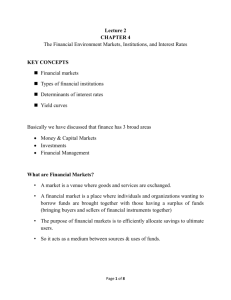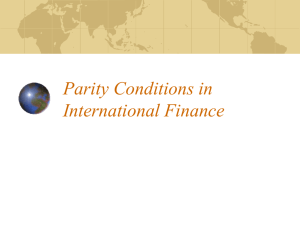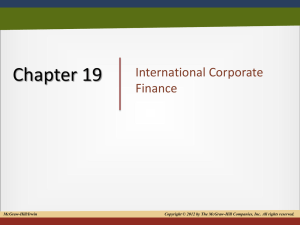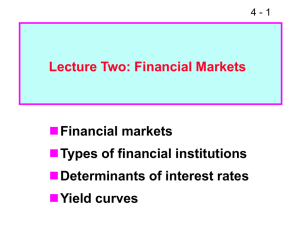Global Financial Markets
advertisement
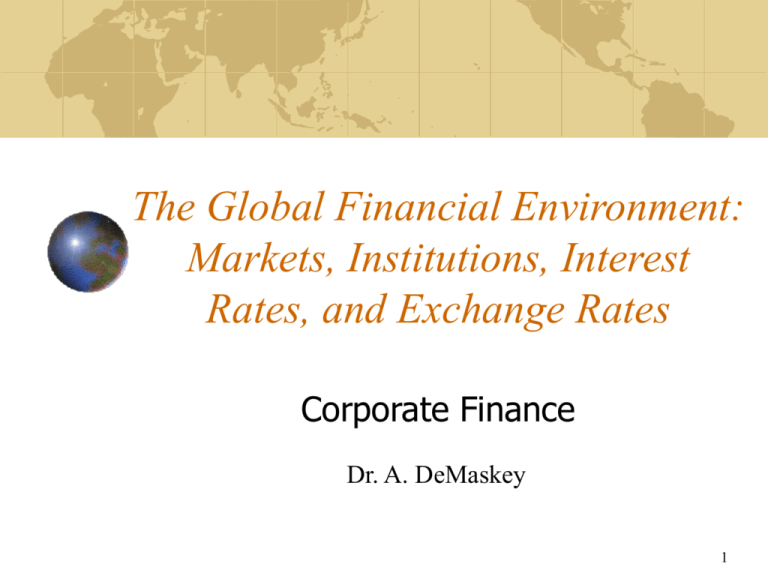
The Global Financial Environment: Markets, Institutions, Interest Rates, and Exchange Rates Corporate Finance Dr. A. DeMaskey 1 Learning Objectives Questions to be answered: What are the major types of financial markets? How is capital transferred between savers and borrowers? What are the major types of international financial markets? How are market interest rates and exchange rates determined? What is the term structure of interest rates? What determines the shape of the yield curve? What other factors influence interest rate levels? How does the level of interest rates affect business decisions? 2 Types of Financial Markets Physical Asset versus Financial Asset Market Money Market versus Capital Market Primary versus Secondary Market Open versus Negotiated Market Spot versus Futures Market 3 Recent Trends in Financial Markets Globalization Derivatives Stock Ownership Patterns 4 Types of Financial Transactions Direct transfer Indirect transfer Through an investment banking house Through a financial intermediary 5 The Stock Market Organized Exchanges versus Over-theCounter Market NYSE versus Nasdaq system Differences are narrowing 6 International Financial Markets Eurodollar markets Dollars held outside the U.S. Mostly Europe, but also elsewhere International bonds Foreign bonds: Sold by foreign borrower, but denominated in the currency of the country of issue. Eurobonds: Sold in country other than the one in whose currency it is denominated. International stocks ADRs: Certificates representing ownership of foreign stock held in trust. 7 What Various Types of Risks Arise When Investing Overseas? Country risk: Arises from investing or doing business in a particular country. It depends on the country’s economic, political, and social environment. Exchange rate risk: If investment is denominated in a currency other than the dollar, the investment’s value will depend on what happens to exchange rate. 8 The Cost of Money What do we call the price, or cost, of debt capital? What do we call the price, or cost, of equity capital? 9 Fundamental Factors Affecting the Cost of Money Production opportunities Time preferences for consumption Risk Expected inflation 10 Real versus Nominal Rates k* = Real risk-free rate. T-bond rate if no inflation; 1% to 4%. k = Any nominal rate. kRF = Rate on Treasury securities. 11 The Determinants of Market Interest Rates k = k* + IP + DRP + LP + MRP Where: k = Required rate of return on a debt security. k* = Real risk-free rate. IP = Inflation premium. DRP = Default risk premium. LP = Liquidity premium. MRP = Maturity risk premium. 12 Premiums Added to k* for Different Types of Debt ST Treasury: LT Treasury: ST corporate: LT corporate: 13 The Term Structure of Interest Rates Term structure: the relationship between interest rates (or yields) and maturities. A graph of the term structure is called the yield curve. 14 Hypothetical Treasury Yield Curve Interest Rate (%) 15 Maturity risk premium 10 Inflation premium 1 yr 10 yr 20 yr 8.0% 11.4% 12.65% 5 Real risk-free rate Years to Maturity 0 1 10 20 What Determines the Shape of the Yield Curve? Expectations about future inflation. Perceptions about the relative riskiness of securities with different maturities. The Pure Expectations Theory (PEH) Shape of the yield curve depends on the investors’ expectations about future interest rates. If interest rates are expected to increase, L-T rates will be higher than S-T rates and vice versa. Thus, the yield curve can slope up or down. PEH assumes that MRP = 0. Long-term rates are an average of current and future short-term rates. If PEH is correct, you can use the yield curve to “back out” expected future interest rates. 17 Observed Treasury Rates Maturity 1 year 2 years 3 years 4 years 5 years Yield 6.0% 6.2% 6.4% 6.5% 6.5% If PEH holds, what does the market expect will be the interest rate on one-year securities, one year from now? Three-year securities, two years from now? Conclusions About PEH Some argue that the PEH isn’t correct, because securities of different maturities have different risk. General view (supported by most evidence) is that lenders prefer S-T securities, and view LT securities as riskier. Thus, investors demand a MRP to get them to hold L-T securities (i.e., MRP > 0). 19 Other Factors That Influence Interest Rate Levels Federal Reserve Policy Federal Budget Deficit or Surplus International Factors Level of Business Activity 20 Trading in Foreign Currencies A spot rate is the rate applied to buy currency for immediate delivery. Spot Exchange Rate Quotations Direct quotation: U.S. dollar price of one unit of foreign currency. Indirect quotation: Foreign currency price per one unit of U.S. dollar. Note that an indirect quotation is the reciprocal of a direct quotation. 21 Trading in Foreign Currencies A cross rate is the exchange rate between any two currencies not involving U.S. dollars. In practice, cross rates are usually calculated from direct or indirect rates; that is, on the basis of U.S. dollar exchange rates. When currencies are not related to one another in a consistent manner, currency arbitrage opportunities exist. 22 Trading in Foreign Currencies A forward rate is the rate applied to buy currency at some agreed-upon future date. Forward premium: FR > SR Forward discount: FR < SR The primary determinant of the spot/forward rate relationship is relative interest rates. 23 Interest Rate Parity (IRP) Interest rate parity implies that investors should expect to earn the same return on similar-risk securities in all countries: f1 1 kh e0 1 k f Here, kh = periodic interest rate in the home country. kf = periodic interest rate in the foreign country. f1 = one-year forward rate e0 = current spot rate 24 Interest Rate Parity (IRP) Interest rate parity shows why a particular currency might be at a forward premium or discount. If domestic interest rates are higher than foreign interest rates, the foreign currency is selling at a forward premium. Discounts prevail if domestic interest rates are lower than foreign interest rates. Arbitrage forces interest rates back to parity. 25 Purchasing Power Parity (PPP) Purchasing power parity implies that the level of exchange rates adjusts so that identical goods cost the same amount in different countries. or Ph = Pf(Spot rate) Spot rate = Ph/Pf 26 Inflation, Interest Rates, and Exchange Rates Lower inflation leads to lower interest rates, so borrowing in low-interest countries may appear attractive to multinational firms. However, currencies in low-inflation countries tend to appreciate against those in high-inflation rate countries, so the true interest cost increases over the life of the loan. 27

